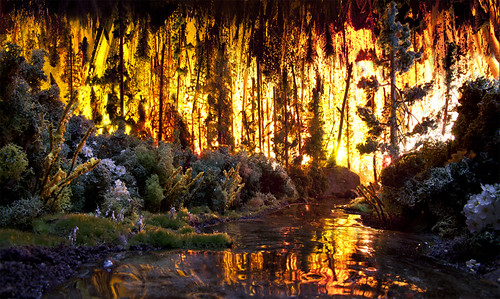When Matthew Albanese began his Strange Worlds project in 2008, he says, it was very much about “tricking the eye.”
“I would describe the photography that I do as small scale dioramas that I build by hand out of everyday, simple, mundane materials and transform them into an image through the lens of my camera making them look hyper-realistic,” he says in the accompanying video episode of The Weekly Flickr. “I’ve used ostrich feathers to create willow trees. I’ve used steel wool to create a tornado. Nothing is off limits.”
By day, Matthew is a professional fashion photographer. By night, for the last five years, he’s been creating large dioramas of tiny environments and photographing them. If you knew nothing about his process, you’d think his photographs were of real life places.
He stumbled upon his Strange Worlds idea by accident one day while in the kitchen at work.
“The first Strange World that I created was Paprika Mars,” Matthew details. “I had spilled paprika in the kitchen and instead of cleaning it, I was playing with it. It was the color and the texture and I just had the inspiration to create Mars out of it.”
Ever since he can remember, he has always been a “daydreamer.”
“When I was young I was always very, very obsessed with movie miniatures and movie magic and things of small scale,” he says. “Even just to see a place that I couldn’t see in person, it was a way for me to try to see the surface of Mars.”
Matthew began building his creations in the back of his father’s old warehouse. He has since moved the production of his Strange Worlds to his living room.
“Having these in my living room can be overwhelming most of the time. They take up so much space and so much time to create that I have to literally walk over them, walk under them, and walk around them,” he says with a twinge of frustration. “I don’t have many visitors.”
It can take him anywhere from three to seven months to build one Strange World and he takes thousands of exposures to document the process.
“I’ll make a change, and I’ll make a capture. And, I’ll make another little change and I’ll make a capture,” Matthew says.
When he is done building the diorama, he sets the lighting and prepares the special effects.
“I do minimal digital editing on my work,” he explains. “The most I will do is composite different parts together in order to get the right exposure.”
When he is done photographing scenes, he usually destroys the dioramas because they are not really built to last.
Matthew gets his inspiration from a number of sources.
“‘How to Breathe Underwater’ came around at a time in my life where I was sort of overwhelmed by everything that was happening to me,” he says. In this Strange World, “I used jelly beans carved and rolled by hand to create sea anemones. I used wire coated in fabric glitter to create some kind of sea urchins, and brain coral was made out of walnuts.”
But the process is not always easy, he admits.
“I have been very discouraged many times building these. It can be very frustrating,” Matthew says. “But I found that making mistakes was the best thing for the work because I was able to discover methods and strategies to build future landscapes.”
When people look at his photos, Matthew hopes onlookers see beyond the shock value of the materials that he uses and the result.
“I hope that they see more than just a pretty picture of a landscape,” he says. “I hope they have a strong emotional connection to the work.”
“When I look back on my body of work, I feel a sense of accomplishment,” says Matthew. “The thing that is most fulfilling is knowing that I can inspire someone like me to get out there and create something. If I can create the surface of Mars out of paprika and a tornado out of steel wool, there is nothing you can’t do.”
Matthew Albanese’s first book Strange Worlds, with a text by David Revere McFadden, will be published by Lazy Dog Press in Spring 2013. You can also follow Matthew’s activities on his Facebook fan page.
More from The Weekly Flickr: Share your photos in The Weekly Flickr group for a chance to be featured in an upcoming episode, and tweet about this video series with #theweeklyflickr.
Or watch previous episodes of The Weekly Flickr: The story behind amazing WTC pics | The Weekly Flickr wishes you a happy New Year | Budding photographer finds living in surrealism | Breezy Point will be back
Follow Flickr on Twitter to get updates about upcoming The Weekly Flickr episodes: [twitter-follow screen_name=’flickr’ show_count=’yes’]








